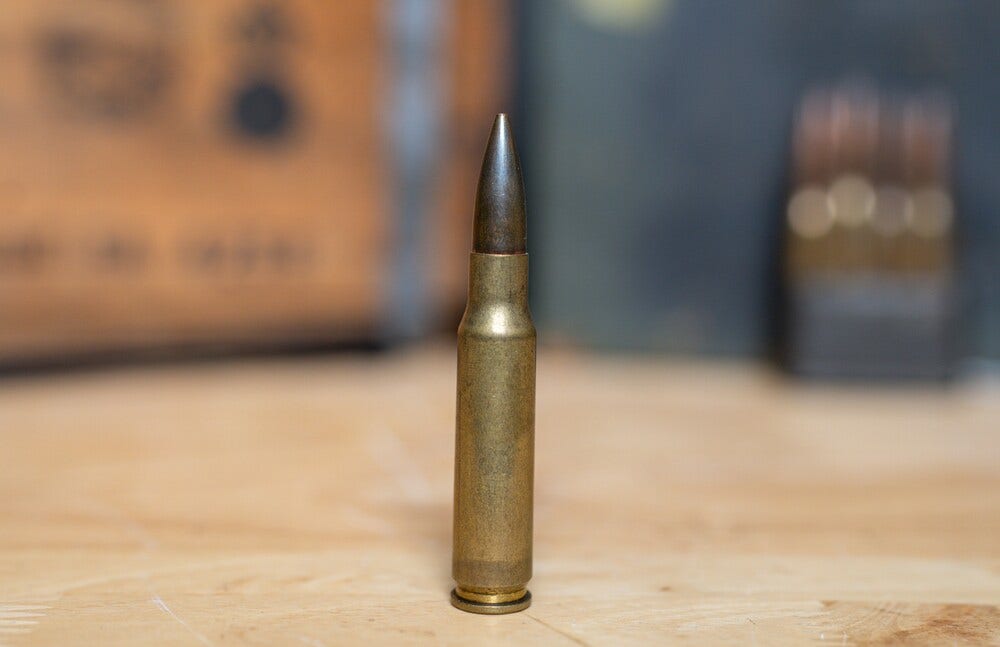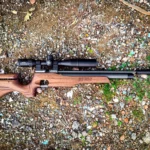The U.S. military drove the development of both cartridges, but the similarities—other than the mandatory bullet, case, propellant and primer—pretty much end there in a .45-70 Gov’t vs. .308 Win. comparison. The former is one of the oldest designs still in commercial production, with good reason. The other isn’t exactly a youngster, celebrating its 70th birthday this year, but it’s still serves with honor with our armed forces across the globe in its lower-pressure 7.62 NATO iteration.
The secret to their longevity is enviable performance, but in vastly different applications. They rarely, if ever, shine in the same duties. A look at their numbers tells the tale.
Table of Contents
History
.45-70 Gov’t
The U.S. Army adopted the .45-70 Gov’t in 1873, three years before Gen. Custer’s ill-fated last stand. The military requirements it met prior to approval included 4-inch groups at 100 yards.
Today groups that wide are almost unheard of, even from abused rifles. It was a different time, though, the original cartridges used blackpowder for propellant and gun making wasn’t as precise. Bullet manufacturing was far from scientific, too.
The official designation at introduction was .45-70-450, with the middle number reflecting powder charge and the last indicating bullet weight. Subsequent testing indicated heavier projectiles increased effective range, so in 1879 (too late for the 7th Cavalry, not that it would have helped) the .45-70-500 became standard issue. The military put an end to the cartridge’s 19-year run in 1892 when it adopted the .30-40 Krag, although rifles in the older chambering continued use for some time.
Combine modern smokeless powder, improved projectiles and CNC-produced rifles and one-inch groups at 100 yards are no longer unicorn rare with the cartridge. At long-distance, however, the trajectory and energy still fall in dramatic fashion.
The .45-70 Gov’t term is shorthand for .45-70 Government, but there are other labels. Some call it the .45-70 Springfield (for the first rifle chambered for it) or simply .45-70. Hornady includes it in a parenthetical listing as the 1895 Marlin.
It’s earned a variety of names, likely a byproduct of age., but the same can’t be said for the .308 Win.

.308 Win.
Members of the North Atlantic Treaty Organization officially adopted the 7.62 NATO cartridge in 1954, two years after Winchester introduced the .308 Win. to civilians. The pair are virtually identical, although the former’s slightly lower pressure allows it to run safely in either chambering—.308 Win. ammo, on the other hand, is not ideal for guns chambered for 7.62 NATO.
Accuracy from the cartridge is almost legendary. It’s used in long-distance competition to this day and favored by some of the world’s best precision shooters. The records it set were staggering, although many—likely all soon—are being eclipsed by a new slew of .300 and .338 Magnums, .50 BMGs and others.
Its ageless versatility took the spotlight, however, during the global war on terrorism, when operations began in Afghanistan. Engagements there were often ridgeline to ridgeline, out of the effective range of the standard-issue M4 and 5.56 NATO cartridge. Expensive precision rifles designed for serious long distance aren’t widely available, so armorers came up with an innovative solution.
M14s chambered for 7.62 NATO mothballed for decades were retrofitted with modern furniture. Issued to designated marksmen within platoons they could stretch the distance and neutralize insurgent snipers who, until then, could rain deadly fire on platoons largely unencumbered.
That’s just the primary advantage of the .308 Win. and its 7.62 NATO fraternal twin. Despite the slight and virtually undetectable physical different, both are predictable in flight and deliver fight-stopping energy at distance.
For that reason, and the fact it can run in every firearm design, the .308 Win. is often claimed to be the most popular hunting cartridge in the United States. The short-action cartridge gained a whole new generation of enthusiasts with its uncompromising performance in AR-10s.
Ballistics
Velocity and Energy
The .40-70 Gov’t bullet has a diameter of .458 inch and the projectiles loaded in today’s cartridges are, in most cases, heavy enough to put big game down with one-shot authority—with proper shot placement at moderate distance. Federal Premium’s 300-grain Trophy Bonded Bear Claw load is one of the heavyweights availably today, but it helps illustrate the dramatic ballistic difference for a .45-70 Gov’t vs. .308 Win. comparison.
The bullet leaves Federal’s test barrel at 1,850 fps. The sheer mass of that projectile, however, means it is carrying 2,280 ft.-lbs. of energy at the muzzle.
The .308 Win. has a bullet diameter of .308 inch. Federal Premium’s 180-grain Trophy Bonded load in the cartridge exits the gun at 2,620 fps with 2,743 ft.-lbs. of energy—the winner by a wide margin. At 300 yards it has slowed down to 2,277 fps but still manages to have 1,789 ft.-lbs. of knockdown power. At that point, the above .45-70 Gov’t load’s figure drops to only 797, roughly half.
Even with lighter bullets in the .45-70 Gov’t the drop-off is dramatic. Hornady’s LEVERevolution line includes a 250-grain load that manages 2,025 fps leaving the barrel with 2,276 ft.-lbs. of energy. Despite the higher initial speed, its energy figure still plummets to 636 at 300 yards. At 200, if you’re wondering, it’s 918.
The figures may leave some wondering why the cartridge has survived for nearly 150 years. Its secret lives inside somewhere inside 150 yards, where most hunters in the United States take their big game. It’s there that the energy is sufficient and, when combined with the wider bullet diameter, it’s a combination that fills tags. It really shines for big game up close—tough ones, like American bison and big bears.
At 100 yards the Federal .45-70 Gov’t load carries a 1,569 ft.-lb. punch. Hornady’s lighter bullet delivers 1,450. Add modern bullet design and both hit with tag-filling authority.
Legacy
It also oozes nostalgia. The single-shot Springfield Trapdoor rifles carried by Gen. Armstrong Custer’s troopers at the Little Bighorn were chambered in .45-70-Gov’t. The bullets their cartridges wore weighed an even more formidable 405 grains.
Its design, however, precludes use in semi-automatic firearms. The profile is even a challenge when it comes to bolt-action rifles. Not many exist and their scarcity makes them popular among collectors.
The .308 Win., however, lends itself to reliable feeding and extraction in every method of operation. It’s available in semi-automatics, like the AR-10, bolt actions, single shots and even lever actions.
.45-70 vs. .308 Exterior Ballistics
The .308 Win. also has a flatter trajectory. Zeroed at 100 yards, the Federal 300-grain .45-70 Gov’t bullet drops 13.4 inches at 200 yards and more than four feet at 300. The company’s 180-grain .308 Win. load, with the same zero drops 3.4 inches at 200 yards and 15.4 inches at 300. The difference is huge and widens with distance.
Add a 10-mph full value wind and the .308 drifts 6.9 inches at 300 yards. At that distance, in the same breeze, the company’s .45-70 Gov’t load has moves more than two feet. Doping the wind is not an endeavor easily done by a novice, and a challenge for most experienced enthusiasts.
Any discussion of a cartridge’s potential accuracy is dubious, at best. There’s no doubt today’s cutting-edge CNC gun manufacturing has tightened groups in every firearm, regardless of chambering. One-hole groups are possible with either cartridge, in the right conditions. The exterior ballistics, however, make it obvious that the .458-inch diameter projectile requires a skilled marksman behind the trigger and quality ammo.
As a result, the .45=70 Gov’t has a relatively reputation for being inaccurate. Its origins as an early military cartridge laid that foundation.
Which One is Best?
Deciding which cartridge is best always comes down to individual preference and application. The .45-70 Gov’t is big, heavy and hits with undeniable authority at medium distance. With proper shot placement it will usually convince a big bear that its charge wasn’t such a good idea. It falls off quickly when things get long, although those lever-actions or single-shots are a blast from the past. They also add challenge to many favorite pursuits.
There’s a virtually unlimited number of firearms chambered for .308 Win. Regardless of what it’s in, the cartridge performs, is usually less expensive, much easier to find in the store, and if you’re going to stretch the distance wins by a wide margin. It’s businesslike and precise.
You can’t go wrong with either cartridge, but it’s a rare knowledgeable gun owner who doesn’t have at least one .308 Win. in their gun safe—and there’s good reason for that fact.










































